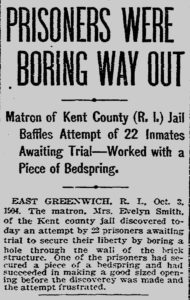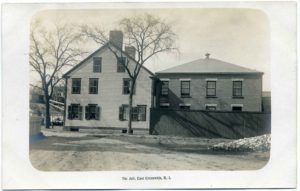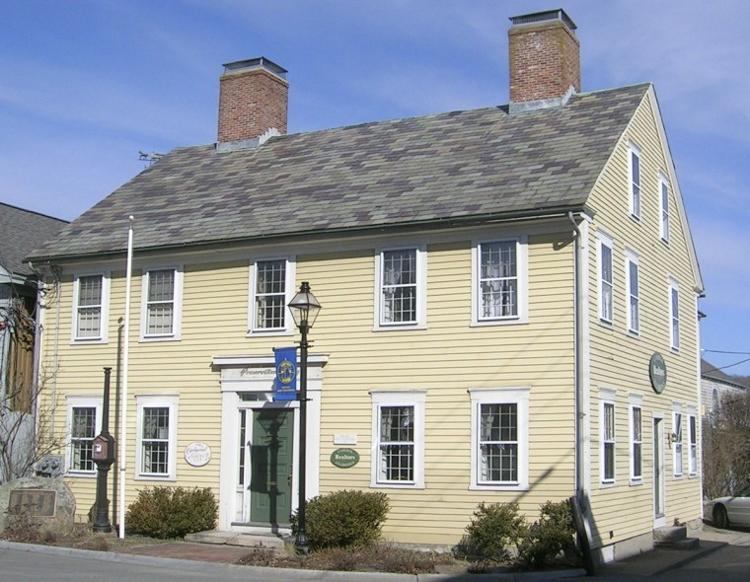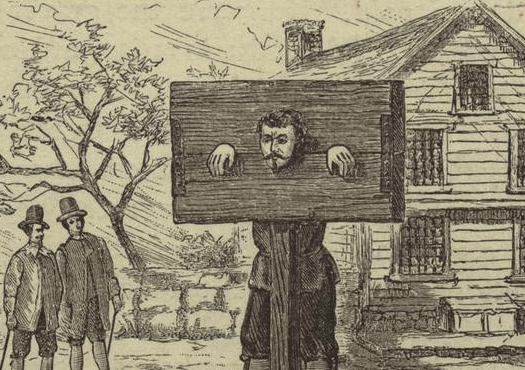One of the most remarkable women in the state’s history lived and worked in East Greenwich. In fact, she spent her childhood at the Second Kent County Jail and died there, at the age of eighty, on September 1, 1925. She was Everlin (Place) Smith, the Jailkeeper of Kent County for nearly fifty years.
Although it was extremely uncommon for a woman to be a jailer, it was not unheard of. In March 1786, the Rhode Island General Assembly voted and resolved: “That Three Pounds Sixteen Shillings and six Pence, lawful Money, be allowed and paid, out of the General-Treasury, to Mrs. Hannah Smith, Keeper of the Gaol in the County of Kent, it being the Amount of an Account by her exhibited, for the Maintenance of divers [sic] Prisoners, committed at the Suit of the State.” Hannah Smith was likely one of the very first women to serve as a jailer in the country. She became the jailkeeper in 1785, after the death of her husband Ichabod Smith, the former Keeper of the Kent County Jail. (It is not known if Hannah was related to Everlin.)
Similarly, Everlin became the jailkeeper after the sickness and death of her husband, Jotham Smith. However, unlike Hannah Smith, who was the jailer for a short period, Everlin spent most of the remainder of her life as the jailkeeper.
It seems as though this was the career path that Everlin was destined to follow. Her grandfather, uncle, father, and husband were the Jailkeepers of the Kent County jail before her. After the death of her husband in 1880, Everlin officially took over as the Keeper of the Kent County Jail. During her husband’s illness, she had been running the jail as well.
In the 1880 United States Census, taken around June 1, 1880, Everlin, 33, is listed as Jail Matron, widow, with two children, Annie, age 11, and Minnie Smith, age 8. The only other member of the “household” was John Lillis, 23, prisoner.
In 1880, her first year as the official Matron of the Jail, Everlin had a cold-blooded murderer to confine at the jail. In the village of Summit in Coventry, Isaiah Carr had shot and killed his nephew, Caleb Carr. Isiah Carr was brought to the Kent County Jail. At 7:30 am on Wednesday, July 28, as Everlin came to Isiah’s cell to serve him breakfast, she found his lifeless body. He had strangled himself with his pocket-handkerchief standing on a chair. In those days, there were no protocols for handling prisoners considered to be high risks for committing suicide. Everlin had to testify at the coroner’s inquest.[1] This job certainly was not for the faint-hearted.
The Boston Globe edition of February 17, 1901, ran an article entitled, “Woman As a Jailer: Mrs. Evelyn [sic] Smith, Keeper of a Rhode Island Prison, Has No Fear of Lawbreakers, and Never Has Any Trouble Even With the Most Desperate Characters Entrusted to Her Watchful Care.”

A 1904 newspaper clipping describing how Everlin Smith foiled a planned jail break (East Greenwich Preservation Society)
The article noted that one of her “guests” was William McCaughey, “one of the notorious ‘wire gang.’” “Tug,” as he preferred to be called, had implicated the “gang” in the murder of young socialite May Fosburgh. It was a sensational crime that made headlines around the country. In fact, May’s mother, Mrs. Robert Fosburgh, came to the Kent County Jail to interview “Tug.”
The article went on to note:
Mrs. Smith is an amiable, a motherly, an honest and a resolute woman. If she lacked courage she would not be the successful jaileress she has been during the past 20-odd years. She treats her prisoners well and they return her kindness by behaving themselves, at least while they remain in the Kent County jail.
If a prisoner behaved properly, he could be given the freedom of roving around part of the jailhouse during the day. If the prisoner behaved badly, he would be confined in a small, stone cell with iron bars.
At that time, in 1901, only one jail break had ever occurred under her watchful eyes. It occurred in 1889, shortly after the new brick jail was built. The Rhode Island Pendulum edition for Friday, December 27, 1889, reported:
Only three prisoners were in confinement at the time. They were George Morris, Fred Rockwood and Dan Donahue. All were awaiting the action of the Grand Jury, the last upon a charge of breaking and entering, and the other two upon a charge of larceny. The escape was effected through a breach in the east wall, made by the aid of an iron bar wrenched from a bed-stead. The hole is about 2 by 3 feet. The walls are made of brick and have scarcely had time for the cement to dry, so that the task was not a difficult one. The escaped prisoners were seen soon after they had gained their liberty, going toward the railroad track and undoubtedly went to Providence. The fact that the jail has been so recently built, and that these were the first prisoners in it since its completion, has given rise to much adverse comment as to its proper construction, plans, etc.
In the 1901 Boston Globe article, Everlin was asked how she was able to maintain order with the male prisoners. She replied:
Well, I don’t exactly know, except it is that a man has more respect for a woman than he has for a man. There have been lots of tough and hardened men in the jail since I first came here, and they have behaved themselves very well. A little civility goes a great ways, and with a fair degree of treatment, the prisoners soon like to keep the jail orderly and they thereby secure all the more liberty and privileges. That means a great deal to them when they are confined behind the bars.
It was also noted in the article, “the men have their three meals a day with cake or pie at each one of those meals. At every meal white bread and butter with the meat food are served, and the supper has both cake and pie to accompany the cold roast or the hot clam chowder.” Evidently, Everlin’s culinary skills helped set her apart from her male counterparts in her chosen profession.
Prisoners might arrive at any time, day or night, from all over Kent County, to be placed in her care. One can only imagine the amount of work that went along with her duties as the Jailer, the cooking, cleaning, and paperwork. At the same time, she raised her own children.

The second Kent County Jail, circa 1910, when Everlin Smith continued to be the Jailkeeper. Note fence around back portion of jail. (East Greenwich Preservation Society)
The Boston Globe article contains interesting details about some of the prisoners who had been confined at the Jail:
During the time Mrs. Smith has been the jailer in Kent County there have been a number of prisoners there who have been accused of murder. Among these was George Congdon, who shot one Wilcox at Oakland Beach. He was convicted and later sent to Cranston.
The hardest prisoner Mrs. Smith ever had to contend with was Charles Burns, and he made trouble for every one about the jail. Burns was held for burglary and he was the most contrary man that was ever registered in the jail, but withal he was fairly obedient to Mrs. Smith herself. When she was absent for any length of time he would mind no one, and in consequence he would be locked in his cell for the time being. Burns was recorded as the bad man of the jail, the very worst in the 20 years of Mrs. Smith’s service to the state of Rhode Island.
It is a singular thing, but Mrs. Smith is given no method of punishment for a contrary prisoner, except to confine him in a cell, but she says this is an effective way of curing men of their ugliness and they soon come around and decide to behave themselves.
In all the years of keeping the jail, Mrs. Smith has never been assaulted nor attacked by a prisoner.
It should be noted that not all those kept at the jail were hardened criminals. A large majority were arrested for petty crimes like public drunkenness. Debtors and bankrupts were also placed under her care.
As charming as the Boston Globe’s account of her life as the Kent County Jail Keeper is, Everlin must have seen her share of unsavory incidents at the Jail. Imagine her shock on July 18, 1911, when she discovered Samuel Hambler dead in his cell. He had committed suicide by rubbing his neck back and forth on the sharp edge of his bed frame until he had slit his own throat. He had been taken up for being drunk the night before.[2]
Everlin died in 1925, still at her post. Her obituary in the Rhode Island Pendulum’s September 3, 1925, edition is meager for such a formidable woman: “Mrs. Evelyn [sic] Smith, 80, died Sept. 1st at her home at the Jail where she was matron for many years.”
The former Kent County Jail that Everlin served in is now the headquarters of the East Greenwich Historic Preservation Society.
Notes:
[1] The Rhode Island Pendulum, July 30. 1880. [2] The Brooklyn Daily Eagle (Brooklyn, Kings, New York), July 18,1911.
[Banner image: The second Kent County Jail was built in 1796. It is now the home of the East Greenwich Historical Society (Bruce MacGunnigle)]

























